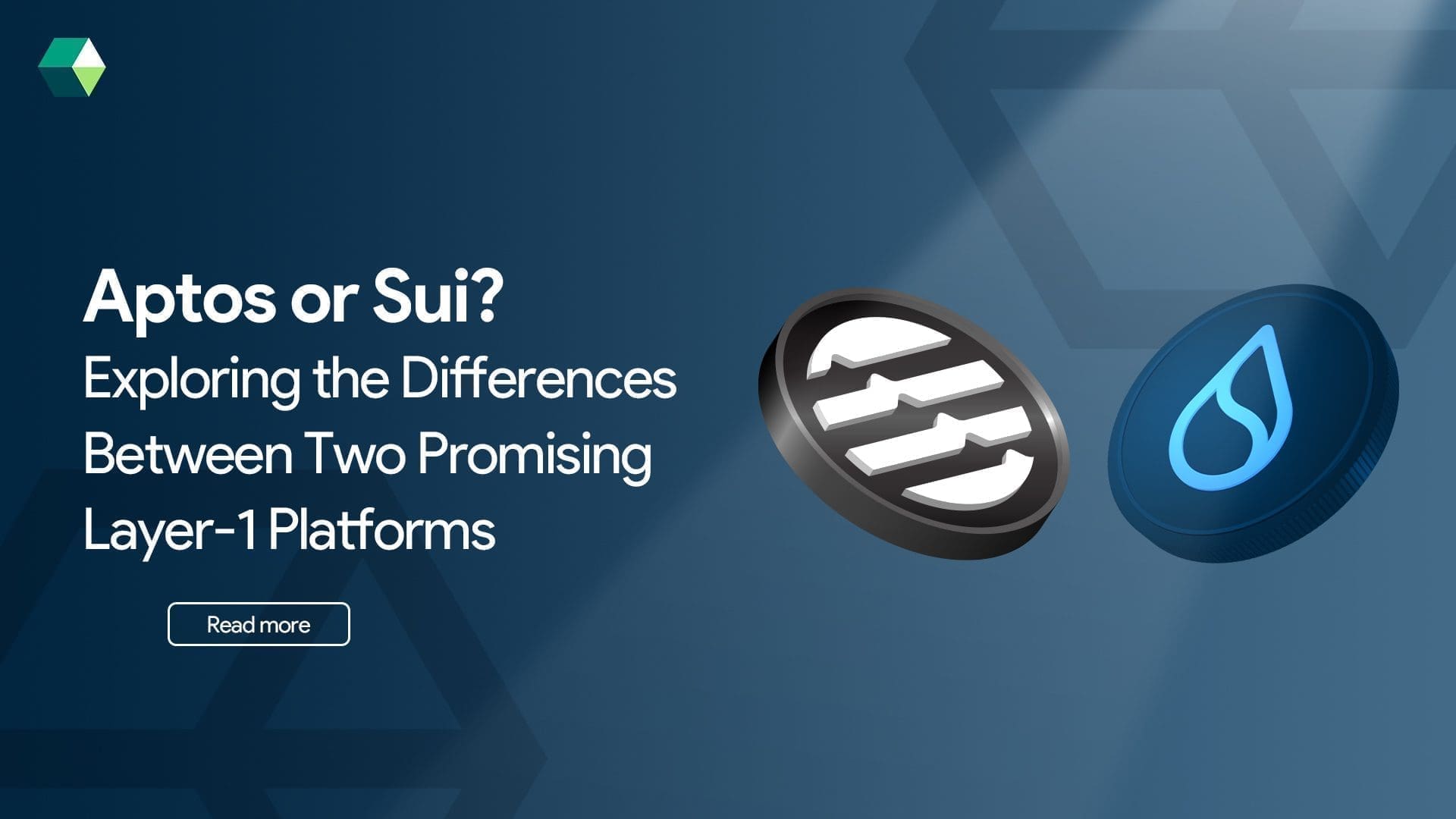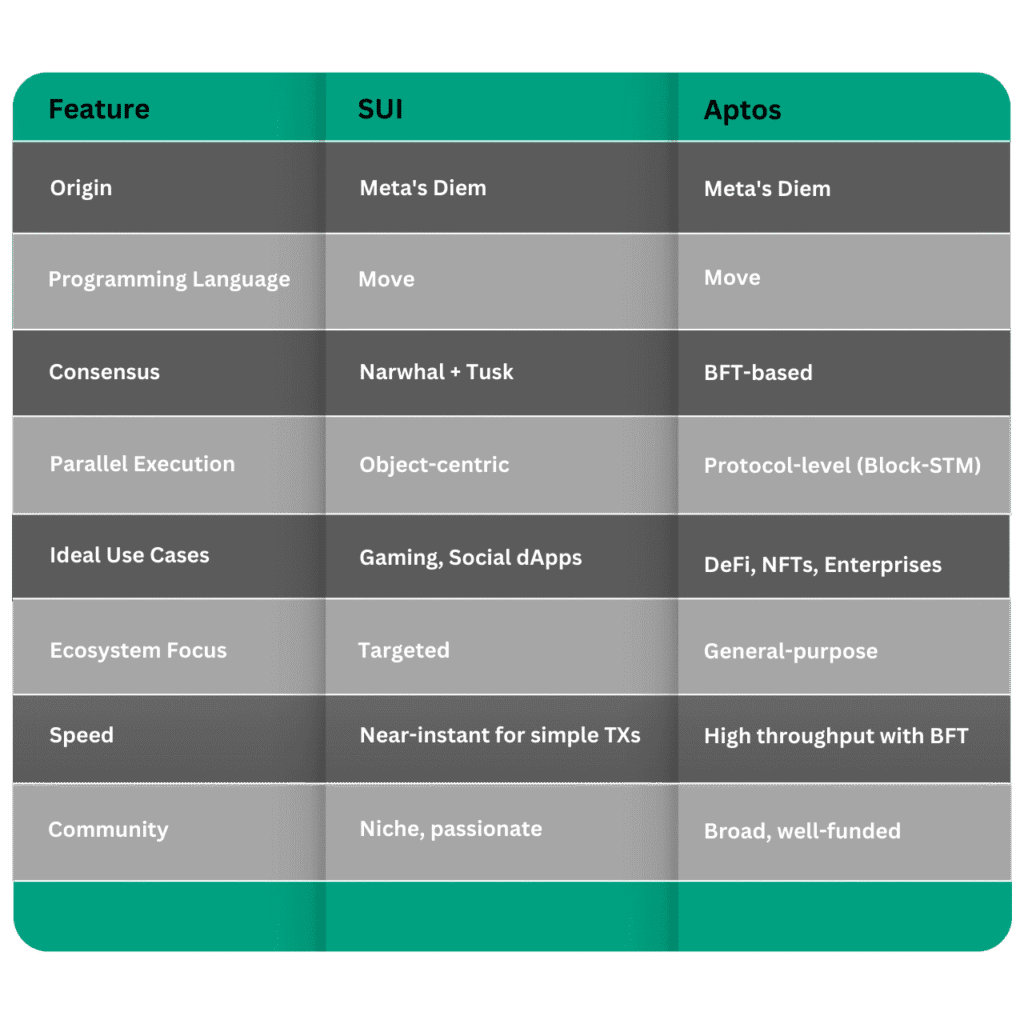
Blockchain technology is rapidly evolving, with an increasing number of Layer 1 solutions emerging to address the shortcomings of legacy networks. Among these innovative projects, Sui and Aptos have captured significant attention for their potential to revolutionize scalability, performance, and security in decentralized applications. These two Layer 1 blockchains, both originating from Meta’s discontinued Diem project, have distinct architectures, blockchain solutions focuses, and unique ecosystems.
In this comprehensive blog, we explore the key similarities, architectural differences, developer ecosystems, use cases, and real-world potential of Sui vs Aptos. Whether you’re a blockchain enthusiast, a developer, or a business looking to build dApps, this deep dive will help you understand the nuances between these two powerful Layer-1 solutions.
Understanding the Origins of Sui and Aptos
Both Sui and Aptos trace their roots to Meta’s Diem blockchain project, which was originally intended to create a stable and scalable global financial system. When Diem was ultimately abandoned due to regulatory hurdles, some of its top engineers took their learnings and created new ventures—giving birth to Sui (developed by Mysten Labs) and Aptos (developed by Aptos Labs).
These blockchains share not only a technical lineage but also a common foundation in the Move programming language, a powerful smart contract language originally developed at Meta to ensure digital asset security and safe resource handling.
Sui Blockchain
Sui is a cutting-edge Layer 1 network designed to provide ultra-fast transaction speeds and scalability, addressing some of the common bottlenecks that plague traditional blockchain platforms. By utilizing the Move programming language, Sui enables secure smart contract execution and parallel transaction processing. The network’s architecture leverages a unique consensus model, ensuring transaction finality in near-instant times, which is particularly useful for high-frequency applications like DeFi, NFTs, and Web3 gaming.
The Sui Blockchain is optimized for real-time applications where transaction speed and responsiveness are paramount. Its ability to handle millions of transactions per second with low latency makes it an attractive option for industries demanding performance at scale.
Aptos Blockchain
On the other hand, Aptos also leverages the Move language but focuses more on reliability, throughput, and enterprise-grade solutions. Aptos employs Block-STM, a high-performance parallel execution engine that allows the platform to achieve high levels of throughput and efficiency. Aptos prioritizes security and scalability, positioning itself as a versatile Layer 1 blockchain solution for industries ranging from DeFi to NFTs and supply chain management.
Aptos aims to be a general-purpose blockchain that serves a wide array of use cases, such as decentralized finance, NFTs, and enterprise solutions, providing a more flexible option than Sui’s focus on specialized ecosystems.
Shared Ground Between Sui and Aptos
Despite their architectural differences, both Sui and Aptos share several key similarities:
-
Origins from Meta’s Diem Project
Both Sui and Aptos were built by engineers who originally worked on Meta’s Diem (formerly Libra) project. The engineers utilized their learnings from Diem to develop these innovative Layer 1 platforms.
-
Move Programming Language
The Move language plays a central role in both platforms. Designed for safe, high-performance execution of smart contracts, Move’s resource-oriented nature enables secure, traceable, and efficient management of digital assets. This shared language makes it easier for developers to transition between platforms while maintaining compatibility with the existing blockchain ecosystem.
-
Scalability and Speed
Both blockchains emphasize high throughput and low latency, addressing the scalability challenges of earlier blockchain systems. Their use of parallel transaction execution allows them to process millions of transactions per second without sacrificing performance.
-
Developer Ecosystem and Tooling
Both Sui and Aptos provide developer-friendly environments. They offer comprehensive documentation, funding opportunities, and easy-to-use tools that attract both experienced developers and newcomers to the blockchain space. As a result, these platforms are ideal for building decentralized applications (dApps), DeFi protocols, and NFT platforms.
Sui vs. Aptos: Key Differences
While both Sui and Aptos are advanced Layer 1 blockchains, their underlying design philosophies differ significantly. Let’s examine some of the key distinctions:
-
Consensus Mechanism
Sui employs a hybrid consensus model called Narwhal and Tusk, which divides transactions into simple and complex categories. Simple transactions, which don’t require full consensus, are finalized instantly, improving speed for applications that require near-real-time transaction finality.
Aptos uses a Byzantine Fault Tolerance (BFT) consensus model. The BFT-based model ensures that the network remains reliable even in the presence of faulty or malicious nodes, making it particularly robust for decentralized application solutions and enterprise-grade solutions that require security and consistency.
-
Parallel Execution Approach
Sui uses an object-centric parallel execution model, which processes transactions based on object dependencies. If two transactions do not interact with the same object, they can be processed in parallel, allowing for high-speed transaction processing without congestion.
Aptos employs Block-STM, a protocol-level parallel execution model. Block-STM allows multiple transactions to be executed simultaneously, significantly improving throughput while maintaining consistency and minimizing congestion.
-
Use Cases and Ecosystem Focus
Sui is built for specialized use cases such as gaming, social dApps, and other high-volume, real-time applications. Its architecture is designed to support fast transaction speeds and low-latency responses, making it an excellent choice for applications that demand performance at scale.
Aptos is a general-purpose blockchain designed to cater to a wide range of use cases, including DeFi, NFTs, and enterprise solutions. Its flexibility makes it suitable for a variety of industries, from finance to supply chain management, and its robust performance makes it capable of handling enterprise-grade workloads.
-
Community and Ecosystem Growth
Sui is focusing on building a niche community around specialized verticals like gaming and social applications. Its ecosystem is growing steadily, attracting developers and companies building in these areas.
Aptos has garnered broad attention and investment across multiple sectors, rapidly growing into a general-purpose blockchain. This widespread ecosystem support ensures that Aptos remains competitive across various industries, from DeFi to enterprise-grade solutions.
Sui vs. Aptos – At-a-Glance Comparison Table

A Complete Guide to Choosing the Right Blockchain Partner
Selecting the right custom blockchain solutions partner is crucial to leveraging the full potential of Sui and Aptos. Whether you’re building a DeFi platform, an NFT marketplace, or a Web3 game, working with an experienced team can ensure that your project meets the highest standards of security, scalability, and performance.
Nadcab Labs is a trusted Layer 1 Blockchain Services that empowers businesses to build innovative solutions on Sui and Aptos. Here’s what makes Nadcab Labs the ideal choice for your custom blockchain solutions needs:
-
Move Language Expertise
Our team is well-versed in Move, the programming language at the heart of both Sui and Aptos. We leverage this expertise to create smart contracts that are both secure and efficient, ensuring your applications run smoothly.
-
Layer 1 Blockchain Experience
With extensive experience in Layer 1 Blockchain Platform, Nadcab Labs has successfully built scalable dApps, DeFi platforms, and NFT ecosystems on both Sui and Aptos.
-
Smart Contract Auditing
From custom dApp solutions to meticulous smart contract auditing, we ensure that your decentralized application is secure, efficient, and future-proof, mitigating any risks before launch.
-
Performance Optimization
Our team specializes in optimizing your applications to leverage the full capabilities of Sui and Aptos—including parallel processing, low latency, and high throughput—ensuring a seamless user experience.
-
Security-First Approach
Security is integral to everything we do. We implement robust encryption, access control measures, and continuous vulnerability assessments to safeguard your assets and ensure the integrity of your blockchain network.
-
End-to-End Blockchain Solutions
From planning and smart contract design to deployment and maintenance, Nadcab Labs offers full-cycle Layer 1 Blockchain Services. Whether you’re building on Sui or Aptos, we ensure that your project runs smoothly from conception to launch.
Schedule a Free Consultation
Looking to build your next-generation application on Sui or Aptos? Get in touch with Nadcab Labs for expert guidance and cutting-edge blockchain solutions tailored to your business goals. Nadcab Labs stands ready to bring your blockchain vision to life on Sui or Aptos. With 200+ blockchain experts, in-depth knowledge of Move, and a passion for building decentralized futures, we deliver performance, scalability, and security.
Start Your Web3 Journey Today
Sui and Aptos both offer high-performance Layer 1 infrastructure with roots in Meta’s Diem project. They embrace the Move programming language and bring innovative parallel execution models to the blockchain space. However, their design philosophies differ—Sui is optimized for high-frequency real-time interactions, while Aptos aims to serve a broader spectrum of decentralized use cases. Whether you’re building in DeFi, NFTs, gaming, or enterprise, choosing the right blockchain platform—and the right Custom blockchain solutions partner—is essential.





